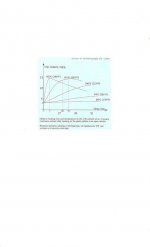I came across a 2008 patent for extraction of pharmaceutically active components from plant materials that described a decarboxylation process they claim to convert 95% of the acid cannabinoids from the acid form to their neutral form--while limiting thermal degradation of THC to CBN to be less than 10%.
So...since I had a batch of lemons and in an attempt to make lemonade, I decarboxylated around 1/2 pound of mediocre bud and made BHO (using the same technique which I have done hundreds of times). Now, about a week and half ago, I blew the same flowers without decarboxylating and when comparing the 2 batches...wow, night and day. The decarboxylated batch is super clean and more potent, very analgesic--and remained viscous oily-tar like (did not stabilize, budder or become semi-solid...which is my normal BHO technique). The earlier non-decarboxylated batch is less intensive, nominal body effect--more stoney, less analgesic.
The specific method I used:
1. 55 grams of flowers were placed in 1/2 gallon Ball- Mason canning jars--(which are designed to withstand 280 plus degrees).
2. Digital thermometer probe placed inside jar but not touching glass.
3. Pre-heat oven to 240 degrees
4. First heating (to dry all material)...I waited until the thermometer registered 220 degrees and reduced the oven to 220 degreds (it took about 45 minutes) and continued to "cook" for 15 minutes, and peaked at 224 degrees.
5. Second heating (to convert acids to neutral form)...I covered the jar (phew, no more aromatics) and continued at 220 degrees for 90 minutes....for flowers high in CBN, the patent suggests 240 degrees at 60 minutes.
6. Cooled for 1 hour...net weight was 45 grams.
7. Hand pulverized the bud as I loaded the tubes and made BHO as usual.
Results...100% increase in "body high"...and enhanced stoney effect...increased THC with massive parts of CBN?
A couple of points to ponder as well, I normally "cure" my trim, flower and shake before blowing, usually about 30-45 days. For the batch that I decarboxylated, the plant was harvested Feb 1, trimmed Feb 8, and on Feb 13, I decarboxylated and blew the herb.
The link to the patent I referenced...and I make special attention to Tables 3-5 (results at different times and temperatures); for optimum conditions--see column #14, line 35.
http://www.freepatentsonline.com/7344736.pdf
The BHO yield went from a low trich yield of 14% to 19%--and the flower (when ripped) is smooth, white ash, with a slight toasty taste; remember...the decarboxylated BHO was from a plant that was basking under HPS about 2 weeks ago.
Is it possible that I can go from harvest to market in 21 days with BHO that is more potent?
Is BHO that can be BOTH smoked and ingested--really be more analgesic?
Has anyone else tried decarboxylating before blowing?
Anyone see any harm/problems/issues if I continue decarboxylating flowers prior to blowing?
Cheers!
So...since I had a batch of lemons and in an attempt to make lemonade, I decarboxylated around 1/2 pound of mediocre bud and made BHO (using the same technique which I have done hundreds of times). Now, about a week and half ago, I blew the same flowers without decarboxylating and when comparing the 2 batches...wow, night and day. The decarboxylated batch is super clean and more potent, very analgesic--and remained viscous oily-tar like (did not stabilize, budder or become semi-solid...which is my normal BHO technique). The earlier non-decarboxylated batch is less intensive, nominal body effect--more stoney, less analgesic.
The specific method I used:
1. 55 grams of flowers were placed in 1/2 gallon Ball- Mason canning jars--(which are designed to withstand 280 plus degrees).
2. Digital thermometer probe placed inside jar but not touching glass.
3. Pre-heat oven to 240 degrees
4. First heating (to dry all material)...I waited until the thermometer registered 220 degrees and reduced the oven to 220 degreds (it took about 45 minutes) and continued to "cook" for 15 minutes, and peaked at 224 degrees.
5. Second heating (to convert acids to neutral form)...I covered the jar (phew, no more aromatics) and continued at 220 degrees for 90 minutes....for flowers high in CBN, the patent suggests 240 degrees at 60 minutes.
6. Cooled for 1 hour...net weight was 45 grams.
7. Hand pulverized the bud as I loaded the tubes and made BHO as usual.
Results...100% increase in "body high"...and enhanced stoney effect...increased THC with massive parts of CBN?
A couple of points to ponder as well, I normally "cure" my trim, flower and shake before blowing, usually about 30-45 days. For the batch that I decarboxylated, the plant was harvested Feb 1, trimmed Feb 8, and on Feb 13, I decarboxylated and blew the herb.
The link to the patent I referenced...and I make special attention to Tables 3-5 (results at different times and temperatures); for optimum conditions--see column #14, line 35.
http://www.freepatentsonline.com/7344736.pdf
The BHO yield went from a low trich yield of 14% to 19%--and the flower (when ripped) is smooth, white ash, with a slight toasty taste; remember...the decarboxylated BHO was from a plant that was basking under HPS about 2 weeks ago.
Is it possible that I can go from harvest to market in 21 days with BHO that is more potent?
Is BHO that can be BOTH smoked and ingested--really be more analgesic?
Has anyone else tried decarboxylating before blowing?
Anyone see any harm/problems/issues if I continue decarboxylating flowers prior to blowing?
Cheers!




